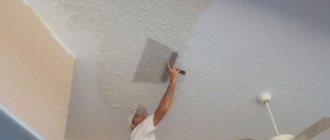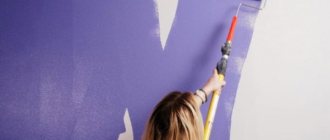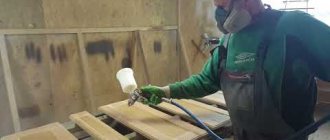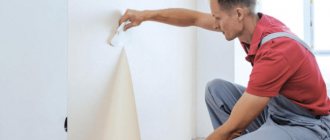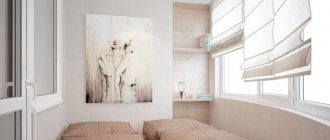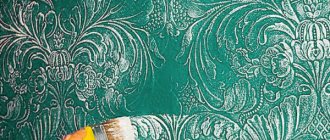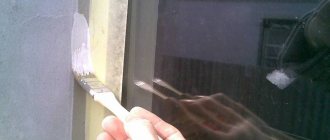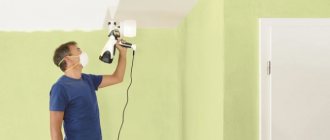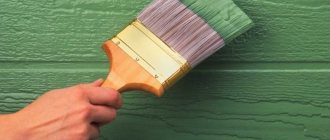Facade paints can be used indoors, however, the characteristics inherent in them for resistance to aggressive environmental influences are redundant for interior surfaces. Therefore, it is more logical to choose specialized interior paint for walls or ceilings for such purposes, depending on what you need to paint.
When using facade paint for interior work, you overpay for qualities that are not needed indoors.
Choosing paint based on base
Is it possible to paint interior areas with façade paint?
For cement, lime bases, surfaces treated with organic materials, and ceramic bricks, it is better to use paints based on vinyl or acrylic. Silicone, acrylic-silicone, silicate, and polysilicon bases are also suitable for such surfaces. Cement and lime paints can be used to decorate the facade.
Silicate plaster and brick - on such surfaces, paints based on silicate, polysilicon, lime, and cement are used.
Wooden surfaces are coated with paint containing alkyd, after pre-treating the surface with an antiseptic.
One of the new and frequently used types of facade paint is textured paint. It creates a protective film on the painted surface, which makes it more moisture resistant and allows you to protect the facade.
Similar information is described on the product packaging. You can also ask the supplier about these characteristics.
Depending on what kind of paint was used for the facade, you can determine whether it is suitable for interior work.
Compositions that are used for painting concrete, stone, wood, and lime surfaces are suitable for painting a room both outside and inside. Only the number of layers applied will differ.
After all, the internal walls and ceiling do not need to be so carefully protected from the effects of external natural factors. But we should not forget about internal influences.
Therefore, painting using such compositions is most appropriate in rooms where the walls and ceiling are constantly exposed to moisture or temperature changes.
Such compositions are suitable in rooms where there is no place for wallpaper and decorative plaster. These rooms include the bathroom and kitchen. Steam constantly accumulates in the bathroom, and grease settles on the walls and ceiling of the kitchen.
Even a good exhaust hood doesn't help. The positive aspects of covering interior walls with façade paint are its water-repellent properties and resistance to wear. You can wash such walls often and safely.
If textured paint was used when painting the facade, then it is not recommended to use it indoors. Due to its peculiarity of creating a protective film on the surface, when such a color is applied to the internal walls, they will stop “breathing”.
This can lead to moisture formation and peeling. In an enclosed space, such qualities of paint can contribute to the growth of fungus and mold, so it is not recommended to paint surfaces with them.
Before applying facade paint to the inside of the house, you need to know exactly what harmful and toxic substances are present in it.
In addition to its aesthetic appearance and protection from various atmospheric influences, facade paint also protects against insects and moss. To achieve this, many manufacturers do not hesitate to add fungicidal additives to the composition.
To effectively combat parasites, their numbers must be high, but this can be dangerous for humans. In addition, by using the remaining facade paint in the kitchen and bathroom, you can significantly save on laying ceramic tiles.
Pros and cons of using facade paint
In any case, it is not for nothing that colors for treating external and internal walls are differentiated; their prices are also significantly different. Therefore, when making calculations and drawing up estimates, it is better to check the parameters several times, recalculate the volumes and material consumption for this volume.
To avoid undesirable consequences, materials must be used according to their intended purpose. But if it so happens that you didn’t calculate it, think carefully and figure out how to make it more profitable, based on the available materials and data.
Information is the main weapon in the hands of a builder. Don't neglect her. Those who have children in their families should be careful about such experiments.
After all, they will be located not only in the nursery, where the space is painted with organic paints, but also in the kitchen, in the bathroom, where the use of facade paint is being considered.
Weigh all the pros and cons, read reviews on construction forums, perhaps someone already has experience using a particular type of color. Similar information can be obtained from the paint manufacturer.
The manufacturing company will not make recommendations to its own detriment, creating the basis for anti-advertising. Based on the data obtained, we can make a final conclusion about the possibility of using a specific facade paint for interior decoration.
Technology and application nuances
No special skills are required when working with acrylic paints; on the contrary, they are characterized by ease of application and lack of drips. However, the lion's share of success lies in careful preparation of the surface to be painted and compliance with the manufacturer's recommendations.
Preparing the base
The specific algorithm of work is determined by the type of base - if wood often requires sanding, then it is enough to clean concrete/brick/stone from dirt and dust. But in any case, the base must be clean, durable and necessarily primed, preferably with a primer from the same manufacturer as the paint. At a minimum, the primer should be compatible with the acrylic paint. Again, primer for wood should have an antiseptic additive, and for metal – with anti-corrosion properties.
Inngrid Member of FORUMHOUSE
I'm about to paint a cast iron battery, I'm choosing from acrylic heat-resistant paints/enamels. They write everywhere that before painting with them it is better to prime the surface with anti-rust primer or a primer directly over the rust (there is rust on the surface of the battery in some places). What primers are suitable for acrylic enamel for radiators?
Yuri Sokolov
There are special primers for rust. There is a 3-in-1 enamel primer, but this is not for batteries; here it’s better to use a primer first. Cover the pre-prepared heating radiator with it. If you paint with acrylic paint, you can use almost any acrylic primer; if the volume is small, take the primer in an aerosol can.
The main thing is that there must be soil. Otherwise, not only will the consumption of not the most budget paint increase, but the quality of the final layer will also deteriorate. It is also important to observe the time interval between layers. How long the primer needs to dry depends on the specific brand, but modern products usually do not require too much downtime and dry in a few hours. If we are talking about loose surfaces with high absorbency, the primer is applied twice - the second layer after the first has dried.
Considering that the composition dries quickly enough so that you don’t have to spend time and tediously washing surfaces that are not intended for painting, you should use masking tape before applying paint. It will also help you get clear, even lines without bleeds if there is a gradation in color or imitation of panels.
Painting the walls
Now let's look at how to paint walls or ceilings. Whatever type of paint is chosen, it can be applied correctly by following the diagram below:
- You can start painting only after the base has completely dried - plaster on the walls and putty, if used. For cement and gypsum mixtures, this time will be different. Quite often, facade surfaces are painted without plaster, for example, the walls inside a loggia or the brickwork of a garage. Inside the house, painting unplastered surfaces can sometimes be a good design move.
- To determine the amount of dye, it is necessary to know not only the total surface area, but also its consumption per square meter. m, and it may vary for different compositions. Naturally, the number of layers applied is also taken into account.
- All work must be carried out at a temperature not lower than +5°C; before complete drying, it is undesirable for the wall to be exposed to moisture or direct rays of the sun - if it dries unevenly, spots will appear on it.
- The surface is first thoroughly cleaned of dust and debris.
- In order for the coating to look perfect, the wall must first be leveled. If there are cracks, they are widened and sealed with a cement-sand composition. Small chips can be repaired with putty.
- To increase adhesion to the surface (adhesion) and reduce paint consumption, walls after plastering are coated with deep-penetrating acrylic primers. This type of primer is suitable not only for acrylic paints and varnishes, but also for other types, i.e. is universal.
- Water-emulsion and acrylic paint that have thickened during storage, if necessary, are diluted with plain water or a special solvent. Alkyd paints use white alcohol, and oil paints use drying oil. Any solvent is introduced in small portions so as not to destroy the bond between the diluent and the coloring pigment.
- To give the composition a certain shade, colored pigments are introduced into it. Since the paint becomes lighter when it dries, it is difficult to immediately achieve the desired shade and determine what color you will get in the end; you need to test it on a small area of the wall.
- To prevent the paint from having to be washed off, masking paper tape is applied to unpainted surfaces. Heavy furniture that is difficult to remove from the room is covered with film. She better also close the windows and doors.
- Work begins in corners and hard-to-reach places.
- Coating with a brush or roller is done from top to bottom. Water-based or acrylic paint can be applied mechanically using a compressor and a spray gun. The roller is used with a fur coat made of synthetic plush or polyacrylic; the length of the pile can be different. For application on top of plaster, a pile of 9-11 mm is suitable.
- When working indoors, painting begins with the ceiling, then moves on to the cornices, moldings, and the walls are painted last.
- If you plan to paint only part of the wall a certain color, separate the border with masking tape. Its location is preliminarily verified by the building level.
- To prevent the joints from being noticeable, they are carefully shaded before the paint dries.
- To obtain a uniform coating, it is better to paint the wall 2 times. In order for the paint to be distributed evenly, the first layer is applied with horizontal strokes using a long-pile roller, and the second - with vertical strokes; in this case, the roller is chosen with a medium-length pile. It is necessary to start re-painting only after the first layer has completely dried.
You can see how walls are painted mechanically in the video:
The advantages of this method over manual painting are the speed of paint application and its more even distribution on the wall.
Read more about painting decorative plaster in our article.
Next PaintingPainting decorative plaster: necessary materials and application methods
Preparing the concrete base for painting
The quality of painting and the service life of the coating depend on the preparation of the base.
Perform operations including:
- cleansing;
- padding;
- processing of junction points;
- putty;
- alignment;
- dust removal.
Cleansing
Remove old coating (paint, whitewash), dirt, splashes, grease stains, etc. Use a spatula to remove old plaster (especially peeled areas). The surface is washed and dried. Areas affected by mold or mildew are treated with chemicals.
Knocking down sagging and sealing cracks
Floor slabs often have ridges or protrusions. They are removed with a chisel or hammer. The sinks and potholes are cleaned, the cracks are expanded along the length with a scraper. After removing the dust, the recesses are primed and then puttied.
Before puttying, the surface is primed. It is recommended to use deep penetration compounds (to ensure adhesion of the base and finishing material).
Apply the primer in several layers (after preliminary drying).
For application, use a roller; in hard-to-reach places, use a brush.
Concrete base putty
After the primer has dried, they begin to level the ceiling with putty. First, seal the joints between the floor slabs using serpyanka or gypsum putty.
Then apply the starting mixture (no more than 2 cm thick). Start from the corner and spread the composition over the ceiling with a spatula. To fill the recesses, press the spatula firmly against the base.
After drying, the surface is sanded with an abrasive mesh, and a second layer of starting putty is applied. The dried surface is primed to increase the adhesion of coatings (starting and finishing).
The finishing coat is applied with a spatula without applying much pressure. After drying, sand with a fine mesh.
Organic solvent based paints
Types of solvents.
- Currently, alkyd and nitro enamels are the leaders in this market; they are based on varnish, due to which they dry quickly enough and form a strong, glossy coating on the surface.
- Most often, enamels are used for painting metal and wooden surfaces in damp rooms. They are still in great demand for painting floors, doors and wooden window frames. This is due to the excellent insulating properties of the coating and good resistance to mechanical damage.
- Alkyd enamels have a wide range of colors, relatively high durability and abrasion resistance. Enamels have good hiding power; they can perfectly mask stains on the ceiling, leaks and various types of dirt. Plus they have good resistance to ultraviolet radiation.
- One cannot help but think about oil paints. In the past they were the most popular, but not so much because of their exceptional qualities, but because of the lack of choice. The biggest advantage of this composition is its price.
Types of drying oil.
This paint is based on drying oil. Drying oil can be on a natural or synthetic basis, depending on this the properties of the composition change. This coating takes a long time to dry, plus it will retain its attractive appearance for no more than 3 years; after this time, the surface will lose its gloss and begin to gradually crack.
Oil composition.
Water based formulations
Initially, you need to clearly understand for yourself what room or surface you are choosing paint for. This will be the kitchen or services, living room, children's room or utility rooms. Depending on this, preference is given to water-based or water-dispersion compositions.
Water-based paints
- These compositions have been known for quite a long time. They are powder formulations that are diluted with water . Their price is the most affordable, they are odorless, and the instructions for applying them yourself are extremely simple. Can be applied with a roller or spray gun, and even a vacuum cleaner attachment will do.
- The water-based emulsion dries very quickly, is completely fireproof and absolutely environmentally neutral . But there are also serious disadvantages: this coating is afraid of moisture; if you wet it a couple of times, it will begin to fall off on its own. Therefore, they are suitable exclusively for dry rooms, and are best used for painting ceilings. The color range is limited to light pastel tones.
Is it possible to paint with facade paint indoors – All about insulation and energy efficiency
Many owners of private houses choose paint and varnish materials for facade finishing.
Facade paints are characterized by increased resistance to negative influences, high strength, good adhesion and reliability.
It is these qualities that allow the material to be used for facade work.
There are situations when it becomes necessary to paint walls with such material, but not from the outside, but from the inside.
Is it worth doing this and what material to choose for this, it is better to understand in more detail.
The first thing you should pay attention to is what exactly is the distinctive feature of materials that are designed to work outside and inside the house. The list of differences is as follows:
The list of differences is as follows:
- The main difference between these paints is that the materials developed for finishing facades have increased performance properties. This is due to the need to delay various negative factors that destroy the coating and walls of the house;
- for façade materials, a prerequisite is the ability to reliably provide protection to the entire house;
- With regards to color, the pigment of such compositions is much richer and has increased resistance to fading.
Facade paint, given its composition, which is designed for more severe and aggressive conditions, is not always completely environmentally friendly. However, the fact that the facade covering is used outside the house, this feature does not matter much.
Based on the above, it can be understood that paint for interior work will not have such qualities, and, therefore, such an aggressive composition.
These materials do not need to be resistant to the negative effects of atmospheric factors.
But there are high requirements for the drying speed of materials and the absence of unpleasant odors.
The main condition for paint for interior work is a high level of environmental friendliness; at the same time, there are paints for facades that are allowed for interior decoration.
Types and characteristics
Paint and varnish materials for facade finishing are produced in various types, which are characterized by a special composition and properties:
- The silicate type is produced on the basis of liquid glass , which contains organic additives and hardeners. It is intended for painting limestone surfaces, houses made of aerated blocks, bricks
and
foam blocks
.
The material is characterized by resistance to atmospheric conditions, a high degree of air and vapor permeability, and non-flammability . Over time, such paint may lose color saturation, and the degree of adhesion to the base coating is initially low. - The oil type is mainly used for painting wooden surfaces . It contains drying oils of artificial origin and a coloring pigment. With its help, you can protect the wooden surface from moisture and prevent putrefactive processes. After covering with oil paint, the surface stops breathing and the paint takes a long time to dry . It cannot be used on alkaline surfaces, since in combination with them it changes color, cracks and falls off. This type of paint does not have a high degree of durability.
- Enamel paints are used for wooden houses and metal elements . They are divided into alkyd and polyurethane. The first is characterized by the formation of a dense, strong, durable structure, however, it is very fragile. The second type is no less durable and additionally has elastic properties, is not susceptible to mechanical stress, and forms a glossy surface. It, like the previous one, cannot be used on an alkaline surface.
- The water-based type is made on the basis of various substances and can be polyvinyl acetate, butadiene styrene, acrylic
,
silicone
and
vinyl
.
PVC-based paints are characterized by a low level of resistance to moisture. They are not used for painting facades. The butadiene styrene variety is highly susceptible to fading after exposure to UV rays . Despite the fact that such paints are produced for facade work, it is not recommended to use this material for the exterior finishing process. For what purpose does the acrylic variety meet all the necessary requirements for façade paints, but cannot be used on a lime surface.
Organic solvent based paints
Types of solvents.
- Currently, alkyd and nitro enamels are the leaders in this market; they are based on varnish, due to which they dry quickly enough and form a strong, glossy coating on the surface.
- Most often, enamels are used for painting metal and wooden surfaces in damp rooms. They are still in great demand for painting floors, doors and wooden window frames. This is due to the excellent insulating properties of the coating and good resistance to mechanical damage.
- Alkyd enamels have a wide range of colors, relatively high durability and abrasion resistance. Enamels have good hiding power; they can perfectly mask stains on the ceiling, leaks and various types of dirt. Plus they have good resistance to ultraviolet radiation.
- One cannot help but think about oil paints. In the past they were the most popular, but not so much because of their exceptional qualities, but because of the lack of choice. The biggest advantage of this composition is its price.
Types of drying oil.
This paint is based on drying oil. Drying oil can be on a natural or synthetic basis, depending on this the properties of the composition change. This coating takes a long time to dry, plus it will retain its attractive appearance for no more than 3 years; after this time, the surface will lose its gloss and begin to gradually crack.
Oil composition.
Types of painting compositions for ceilings
Experts recommend that before carrying out renovations in a room, consider compositions without substances harmful to health.
The choice of suitable paint is carried out taking into account the purpose of the room, the condition of the surface, and the requirements for the appearance of the coating.
Silicone
Water-dispersed composition with silicone resins as a base. Due to its environmental friendliness and lack of odor, it can be used in an apartment.
- resistance to moisture;
- vapor permeability;
- long service life (up to 25 years);
- elasticity (can bridge gaps up to 2 mm);
- resistance to sunlight.
Interesting: Types of polyurethane paints for concrete
Epoxy
A two-component composition that forms a film on the surface after drying.
- the composition is easy to prepare (the ingredients are mixed);
- is moisture resistant;
- can be used for painting surfaces in non-residential premises (garage);
- bright rich color;
- service life is 30-40 years.
Disadvantage: limited color range.
Silicate
The base is liquid glass.
- moisture resistance;
- resistance to sunlight;
- vapor permeability;
- ability to withstand sudden temperature changes;
- antiseptic qualities (prevention of fungi, mold).
Alkyd
The starting material is polyester resins. The composition based on alkyd resins has a pungent odor and takes a long time to dry.
- moisture resistance;
- light fastness;
- resistance to cracks;
- variety of colors;
- possibility of obtaining a matte or glossy surface.
- contains toxic substances;
- low vapor permeability;
- fire hazard.
Acrylic
Consists of acrylic resins and diluted polymers. Depending on the concentration of ingredients, it can be matte or glossy. After application, a film forms on the surface.
In demand due to:
- resistance to moisture;
- ability to withstand temperature changes;
- quick drying (30-120 minutes);
- no odor.
Used for coloring:
- poorly heated rooms;
- outbuildings;
- gyms;
- garages.
What is water-based paint
Such compositions have a wide range. Due to their high characteristics and a huge selection of shades, they are suitable for finishing external as well as internal surfaces of the house.
Great popularity is due to the ability to interact with any substrate - concrete, metal, wood, brick. The paint has average consumption, it dries quickly, is environmentally friendly, and easy to work with.
Water-based mixtures are made from water with the addition of polymers. The properties of enamels are provided by plasticizers, as well as many protective components. They do not contain harmful fillers; no toxic fumes will be released during use inside the house. The substances are insoluble in water, because it is a binding component. After its evaporation, a strong, durable film of polymer compounds remains. It is porous in structure and does not prevent moisture from evaporating, so it is perfect for painting mineral-based building materials.
Properties
Selecting paint based on characteristics
Facade paint is not only a design tool, a decorative element, it is also designed to protect the facade of the house from various types of destructive influences. The main factor that can damage walls is precipitation.
Temperature changes are no less destructive. In this case, it is necessary to protect the walls from the appearance of mold and mildew. The main parameters when determining the quality of color for facade finishing are:
- binders;
- water permeability;
- resistance to solar radiation;
- wear and tear;
- consumption;
- drying speed.
It is customary to use resins of synthetic origin as binders (acrylic, silicone, and vinyl-based colors are made from them). In addition, cement, potassium glass, and lime are sometimes used.
Binders significantly affect the quality of paint. Inexpensive colors practically do not contain such substances. To increase the volume, various fillers are added to cheap products, but they do not make the composition better.
It is not possible to verify the actual presence or absence of binders in the paint; this information can only be obtained from the manufacturer.
https://youtube.com/watch?v=_2ZC3FuaILk
Surfaces coated with facade paint must provide a water-repellent effect so that the walls do not get wet or dirty.
A large amount of moisture will contribute to the appearance of cracks and crumbling of the plaster; mold grows well in such places. The coefficient indicating the size of the absorption qualities of the paint is the sign W. A low indicator indicates that moisture resistance is high.
Resistance to solar radiation. By warming up and drying the facade, the sun does not allow fungus to multiply, but excessive exposure to sunlight often leads to the color gradually fading, cracks appearing, and the paint may swell.
This quality of paint is determined by its base. Acrylic-based paints are considered the most durable.
The façade periodically requires removal of contaminants. In addition, the color wears out in places where the wall is frequently touched.
A good paint fastness factor will allow it to remain aesthetically pleasing and virtually untouched for a long time.
Wear is determined by the number of cycles of wet or dry exposure.
Currently, the market offers colors with similar characteristics depending on the volume of consumption. This figure is calculated per 1 m². Less paint is used to cover smooth surfaces.
Do different paints dry the same?
Drying speed is determined in hours. Manufacturers typically provide a couple of values for this parameter. The first is the period after which the next coat of paint must be applied, and the second determines the complete drying of all applied layers.
- oil;
- alkyd;
- acrylic;
- silicone;
- limestone;
- polysilicon;
- cement;
- silicate.
Depending on the material of the surface to which they are applied, combinations of these varieties can be used.
Classification of coatings
Liquid glass serves as the basis for all silicate coatings. The coloring composition contains natural elements and belongs to the group of mineral coatings. Among the significant advantages are:
- Resistant to sunlight.
- Resistance to temperature changes.
- Invulnerability to natural phenomena.
- Breathability.
- Biological stability and durability.
Negative indicators include the toxicity of raw materials and the need to use protective equipment during work. Facade silicate coatings are not washed off and do not have mechanical stability.
They cannot be combined with paint and varnish coatings. Slaked lime serves as the main element of lime paints. This material is highly breathable and resistant to mold. It is available to most consumers due to its minimal cost. Among the disadvantages are instability to atmospheric conditions and a minimum number of colors.
The main substance of acrylic paint for facades is resin. Acrylic paints for facade work are presented in a rich color scheme and are in great demand when decorating facades. Like any other material, acrylic has its advantages and disadvantages. Positive characteristics include a rich range of colors, resistance to wear and mechanical stress, and elasticity. A flaw can be considered low air flow.
Silicone-based raw materials have the structure of an aqueous emulsion. Silicone paints perfectly repel natural precipitation and do not absorb dirt from the environment. In addition, they allow air to pass through perfectly and are not damaged by mechanical stress or changes in temperature. They do not fade or deform from exposure to the sun, and do not collect street dust. Silicone-based paints allow them to be used on many surfaces. One minor drawback of this material can be considered insufficient elasticity compared to acrylic .
Subtleties of application
Surface painting is a rather complex process that requires maximum care. If there is old paint on the walls and it is in good condition, then you do not need to wash it off - you can apply a new layer to it
But, if the old material has already cracked and began to crumble, you will need to thoroughly clean the walls. Before you start applying paint, check to see if the walls are ready to be painted. To do this, use a wooden block.
When all defects have been eliminated, the surface must be checked for its ability to absorb moisture. To do this, run a damp sponge along the wall. If the mark immediately disappears, then the wall must be primed. When you start applying paint, divide the entire wall into several sections in advance. They can be separated by pipes, bends, projections and the like. It is convenient to apply paints and varnishes using a roller using up and down movements. In hard-to-reach places it is more convenient to use a brush.
When one area has already been painted, there is no need to wait until the entire surface is dry. Proceed to paint the other one. There will be no difference in the layering. Please note that the direction you apply the paint depends on how many coats you plan to apply. For example, if there are only two layers, then it is better to apply the first horizontally, and the second vertically.
Roller
When applying the paint composition with a roller, it is recommended to choose a tool that is most suitable in size and corresponds to the paintwork material. Rollers with long pile are used for painting with water-based compositions.
The use of wool rollers is allowed. Devices made of foam rubber are not recommended - the quality of coloring deteriorates. For hard-to-reach places (joints, corners) rollers are not suitable; brushes are used.
The roller is immersed in paint up to the handle, then wetted well and squeezed out lightly. After this, they begin painting.
Properties
Facade paint differs from others in its properties, which explains the popularity of this product.
Among the characteristic features are the following:
- Waterproof. A layer of paint is used to protect the walls from moisture, which is why the product must have low absorption capacity. Otherwise, the facade will get wet and dirty. Also, due to high humidity levels, salts are deposited on the walls and cracks appear. The lower the level of water permeability, the better the paint;
- Wear resistance. Good resistance can be declared when the paint can withstand at least 5,000 cleaning cycles before it is completely erased;
- Paint consumption. As a rule, this parameter ranges from 100 to 300 g per 1 square meter. m, if painting is done in one layer. For surfaces of different quality, the consumption will also be different.
Facade paints are not used for interior decoration. They are not recommended for use in buildings with high levels of humidity, for example, baths and saunas. For cladding such buildings, it is better to use ventilated facades. In order for the paint to adhere better to the facade, the surface must be thoroughly cleaned and then coated with a fungicidal compound.
Material consumption
To know how much paint you need to buy to paint a facade, it is recommended to make all the necessary calculations before visiting the store.
If you have to paint a textured surface, then add another 20% of raw materials to the results obtained. For porous façade surfaces , such as brick and plaster, it is recommended to purchase 50% more material than for other substrates. To be on the safe side, you can purchase one more can of paint. The remaining materials can be used for other purposes.
Can façade paint be used indoors?
Facade types of paint are used only with a composition that meets the requirements for interior work.
These include:
Binders. Silicone and acrylic varieties are suitable for this component of paint. Synthetic resin is used for their production, which gives them good quality and high performance characteristics.
Waterproof level. This indicator should be maximum, since the surface also needs protection indoors
This is especially important if finishing is carried out in the bathroom, kitchen or sauna.
Wear resistance. Regarding this parameter, the best option is to use the acrylic variety
After application, it creates a high-density layer, which is characterized by resistance to any kind of influence, even mechanical. This allows the coating to provide an attractive appearance for a long time.
The paints and varnishes offered on the market have a fairly high drying speed, however, this point should be clarified before purchasing.
NOTE!
Facade paint can be used for interior work, but not all types are suitable for this.
Considering the above, we can identify some types of facade paint that are suitable for interior work:
- Silicone. This variety belongs to the organosoluble variety, the composition of which is based on silicone. It can be applied to plaster wall, brick walls or concrete surface. There are no substances in the composition that can evaporate toxic substances. Some manufacturers produce a variety of this paint that is suitable even for painting children's rooms.
- Acrylic also belongs to the class of solvent-soluble and has a high drying rate. Considering that it was developed specifically for use in non-standard climatic conditions, its composition is capable of providing protective properties to the surface and making it resistant to negative external influences.
- A water-based variety of acrylic paint. The composition contains fungicidal additives that provide the coating with a protective layer that is resistant to various types of biological damage. It is characterized by the formation of a high-strength polymer film. It does not react to external influences and retains its properties for a long time.
Raw material selection criteria
Simply reviewing the technical characteristics before purchasing raw materials for facade finishing is not enough. It is important to find out which coating will be perfectly suited to the original material of the facade and will be able to protect it from adverse environmental influences. Applying finishing material to:
- Tree. Some difficulties may arise. Such walls are mostly susceptible to rotting, moisture collection and instability in front of open fire. Therefore, the coloring composition must provide protection from moisture, be elastic and adhere well to the wooden base. Due to these characteristics, the most acceptable option is the use of acrylic-based raw materials. To ensure vapor permeability, it is recommended to cover the facade with transparent compounds.
- Brick. This type of building material tends to release accumulated salts, which negatively affects the appearance of the structure. It is recommended to select finishing materials taking this feature into account. It is recommended to apply facade coating several years after the construction of the building. The coating material must be resistant to weather conditions, chemicals and mechanical stress. The paint must be breathable and have sufficient elasticity. In most cases, paints based on acrylic or water emulsion are used.
- Foam blocks. This material has high porosity. The coating for such walls should be breathable and repellent excess moisture. For a facade made of foam blocks, it is better to choose raw materials based on silicone or rubber. Other paints may peel over time.
- Concrete. It is a durable coating, but may be subject to destruction over time. To protect the base and give an excellent appearance, paints and varnishes are used. The main requirements for coatings include resistance to low temperatures and natural moisture, environmental friendliness of raw materials, and color fastness. Any materials can be used for such a facade, but it should be taken into account that the paint must be permeable to air. Many manufacturers recommend paints based on acrylic, rubber or silicone.
Thus, the facade coating is greatly influenced by the material of the facade itself.
Main categories of paints
All paint and varnish products are conventionally divided into compositions intended for indoor use and for outdoor use. Let's figure out whether it is possible to paint with facade paint indoors.
Purely theoretically it is possible, but we do not recommend doing this for several reasons:
- From a practical point of view, a composition that can withstand all weather surprises for 20 - 30 years without changing its basic qualities will last 50 years indoors. But think about it, do you want to look at a monotonous interior for most of your life?
- Further, if you decide to remove such a coating, it will be quite problematic to do so, since the compositions were initially developed taking into account strong adhesion to the base.
- Another important factor is the level of hypoallergenicity of the coating. These requirements for coatings used outdoors are not so important and therefore are taken into account less during development.
- And finally, the price. Facade paints can be several times more expensive than interior paints. Taking into account the fact that currently there is a huge selection of compositions intended for indoor use, it is impractical and quite expensive to use facade paints for these purposes.
Next we will talk specifically about the choice of compositions intended for indoor use.
They are also divided into 2 common types:
- In the first, water is used as a base;
- The second one is based on organic solvents.
Interior paints are also divided into:
- by degree of abrasion;
- wet or dry cleaning options;
- to glossy;
- matte;
- semi-matte.
In addition, according to the level of tactile sensations, they are smooth, velvety and silky.
As mentioned earlier, the hypoallergenic nature of the coating plays an important role. The compositions are also divided depending on the type of base: concrete, plaster, brick, wood or metal.
Color range of interior paints.
Safe paint for human health and the environment
How safe is your home? Every evening, tired of the city bustle, stress at work, crowded streets, industrial noise and rather dirty air, we rush home - to our loved ones. Hiding behind the walls of apartments, we regain a sense of security, but are we really protected? Whether the walls themselves pose a threat, how safe the paints are, whether the linoleum recently laid in the nursery is emitting harmful fumes - we never know for sure.
Time and again the question is raised about the content of harmful substances in paints and varnishes that negatively affect human health and the environment. According to Wikipedia, the total annual consumption of paints in Russia is about 1 million tons according to the Federal State Statistics Service. It is difficult to imagine how much the incidence of diseases caused by toxins and harmful substances would increase if all these paints were as harmful as skeptics say.
Modern paint production technologies have long made it possible to avoid the use of harmful components, and many of them have long been banned and are not used. And yet, let’s not hide the truth, there are unscrupulous manufacturers who violate standards and rules to reduce the cost of products.
So what should a person stand in front of a huge paint display in a building materials store do? I can’t get it out of my head that you can inhale some harmful fumes for years without even noticing it, but on the other hand, on almost every can, manufacturers have tried to emphasize the environmental friendliness of the paint and its complete safety for health.
